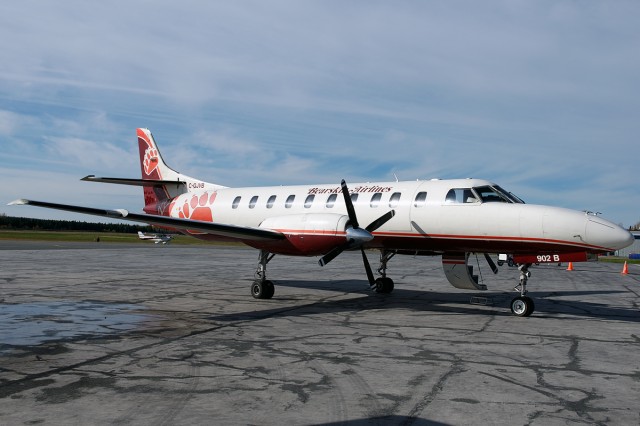In between scheduled flights, I found a Propair employee. I asked him all of one question: “Can I take a look around the Gulfstream?”
His answer, as far as I could tell, was yes.
In between scheduled flights, I found a Propair employee. I asked him all of one question: “Can I take a look around the Gulfstream?”
His answer, as far as I could tell, was yes.

C-GBVY, the Bearskin Airlines Fairchild Metroliner 23 that I flew on. Photo – Bernie Leighton | AirlineReporter.com
This is a continuation of Day of the Turbine (Part 1): Flying on the Convair 580 & Day of the Turbine (Part 2): The Original King Air
The Swearingen Merlin began in a manner akin to the Pacific Airmotive Tradewind. It existed to answer the question, “how can we modernize a Beech piston twin?” By the time Ed Swearingen and his partners had finished their modifications, the aircraft had slowly evolved into its own turbine-powered type. As far as executive aircraft went, the Merlin was relatively popular. It was produced at the Swearingen plant in San Antonio from 1965 until 1998.
The Metroliner came to be as a stretch of the Merlin. It was equipped with the same inverted Garret AiResearch TPE331s, but lengthened to accommodate up to nineteen passengers. Fairchild purchased Swearingen, but continued the Metroliner and Merlin brands. Indeed, they kept production of the Metroliner going until 2001.
C-GJVB, a Metroliner 23, was built in 1998 and I set to take a flight in the classic airliner.
This is a continuation of Day of the Turbine (Part 1): Flying on the Convair 580…
Realistically, Beech knew the 18 was in need of replacement. Though the 18 was produced until 1972, by the mid 1960’s there were thousands upon thousands of light utility, cargo, and twin-engine training aircraft that needed replacement. There was no reason for Beech to forfeit that market.
At the same time, Beech had become successful in the recreational and corporate aviation avenue. Executives who used their salary to buy smaller single-engine Beeches would often buy larger twins, such as the Baron, for their companies. With turboprops becoming popular around the same time and the demand for executive travel growing, Beech needed both a larger Baron and an 18 replacement, in one frame.
The first King Air was almost exactly that – a stretched Baron with Pratt & Whitney Canada PT6A engines. In some ways, the original King Air is reminiscent of a Pacific Airmotive Tradewind with turbine engines. Not many ways other than cosmetic, yes- but it counts!
Propair, operator of the 1972 Beech King Air A100 I would fly on (C-FWRM), is based in Rouyn-Naranda. They fly medevacs, mining charters, and any sort of charter aviation task one would need in rural northern Quebec, up to and including Nunavik. They also operate a Gulfstream I, which we were supposed to fly on, but it went tech a little over a week before our flying day, and was be replaced with an aircraft to be discussed in part three.